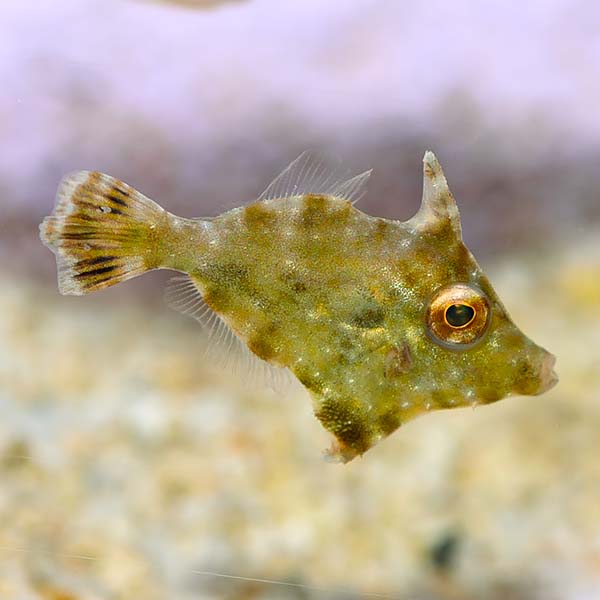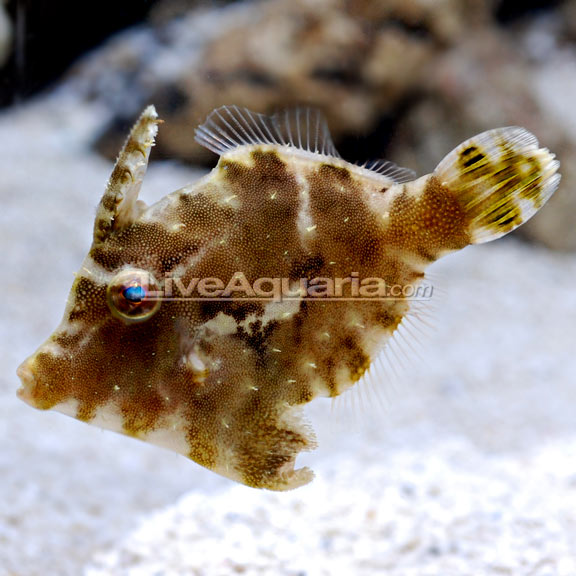Several fish species eat Aiptasia, including the Copperband Butterflyfish and certain types of Filefish. These fish help control Aiptasia populations in aquariums.
Aiptasia, often known as glass anemones, can quickly become a nuisance in saltwater aquariums. They reproduce rapidly and can harm coral and other marine life. To manage these pests, aquarists often introduce natural predators. The Copperband Butterflyfish and specific Filefish species, such as the Bristletail Filefish, are effective at consuming Aiptasia.
These fish not only help maintain the balance in your aquarium but also add beauty and diversity to the tank. Choosing the right fish to control Aiptasia ensures a healthier and more vibrant marine environment.
Introduction To Aiptasia
Aiptasia is a common issue in many saltwater aquariums. These pesky creatures can cause various problems for aquarium enthusiasts. Understanding Aiptasia helps in managing and controlling them effectively.
What Is Aiptasia?
Aiptasia are small, anemone-like creatures. They belong to the sea anemone family. They have transparent or brownish tentacles. These tentacles contain stinging cells called nematocysts. Aiptasia use these cells to capture prey and protect themselves.
Aiptasia can reproduce quickly. They can spread throughout the aquarium. This rapid growth can become problematic for other marine life.
Impact On Aquariums
Aiptasia can have a negative impact on your aquarium. They compete with corals and other invertebrates for space and resources. This can lead to the decline of your beloved corals.
They can also sting and harm fish. This can cause stress and health issues for the fish. Aiptasia can hide in crevices and hard-to-reach places. This makes them difficult to remove manually.
Below is a table summarizing the impact of Aiptasia on aquariums:
| Impact | Description |
|---|---|
| Competition | Aiptasia compete for space and resources. |
| Stinging | Aiptasia sting fish and corals, causing harm. |
| Rapid Reproduction | Aiptasia reproduce quickly and spread. |
Understanding the impact of Aiptasia is crucial. It helps in taking steps to control their population. Keeping your aquarium healthy and thriving is essential.

Credit: www.liveaquaria.com
Why Control Aiptasia?
Aiptasia are small sea anemones that can wreak havoc in aquariums. These pests are known for their rapid growth and their ability to damage coral reefs. Controlling Aiptasia is crucial to maintain a healthy and beautiful aquarium.
Harm To Coral Reefs
Aiptasia anemones can spread quickly and compete with corals for space and nutrients. They often sting corals, which can lead to tissue damage and even death. This can disrupt the delicate balance of the reef ecosystem.
In the wild, Aiptasia can overrun coral reefs, causing significant harm. They outcompete native species and reduce biodiversity. This can have a negative impact on the overall health of the reef.
Aquarium Aesthetics
Aiptasia can be unsightly in a home aquarium. Their rapid spread can make your tank look overrun and messy. They often grow on rocks, corals, and even aquarium equipment, which can detract from the beauty of your setup.
Maintaining a clean, Aiptasia-free aquarium is essential for both the health of your fish and the overall look of your tank. Fish that eat Aiptasia can help keep your aquarium looking its best.
| Fish Species | Effectiveness | Compatibility |
|---|---|---|
| Berghia Nudibranch | Highly Effective | Reef-Safe |
| Peppermint Shrimp | Moderately Effective | Reef-Safe |
| Copperband Butterflyfish | Effective | Not Reef-Safe |
Choosing the right fish or invertebrate can help manage Aiptasia effectively. This ensures a healthy, vibrant, and beautiful aquarium.
Natural Predators
Natural predators are a great way to control Aiptasia in your aquarium. These fish and invertebrates eat Aiptasia, helping to keep your tank clean.
Benefits Of Natural Predators
Using natural predators has many benefits for your aquarium:
- They provide a natural way to control Aiptasia.
- No need for chemicals or manual removal.
- They can help maintain a balanced ecosystem.
Some popular predators include the peppermint shrimp, Berghia nudibranch, and filefish.
These creatures eat Aiptasia and can live peacefully with other tank inhabitants.
Challenges With Natural Solutions
Using natural predators can have some challenges:
- Some predators might not eat Aiptasia immediately.
- They could eat other desirable tank inhabitants.
- Availability of specific predators might be limited.
It’s important to research each predator’s behavior and compatibility with your tank.
Introducing a predator requires patience and careful monitoring to ensure balance.
Peppermint Shrimp
The Peppermint Shrimp is a popular choice for controlling Aiptasia. These small, colorful shrimp are known for their bright red stripes and helpful behavior in reef tanks. Let’s dive into their behavior and diet, and see how effective they are against Aiptasia.
Behavior And Diet
Peppermint Shrimp are nocturnal creatures. They come out at night to scavenge for food. They primarily eat detritus, dead tissue, and small pests. They are peaceful and do not harm other tank inhabitants.
These shrimp have a unique diet. They are known for eating Aiptasia anemones. This makes them valuable in reef tanks.
Effectiveness Against Aiptasia
The Peppermint Shrimp is highly effective against Aiptasia. They seek out and consume these pests. Their small size allows them to reach into crevices where Aiptasia hide.
To increase effectiveness, keep multiple shrimp in your tank. A group works better than a single shrimp. They can clear an infestation faster. Always ensure they have enough food to maintain their health.
| Feature | Details |
|---|---|
| Behavior | Nocturnal, peaceful, scavengers |
| Diet | Detritus, dead tissue, pests, Aiptasia |
| Effectiveness | High against Aiptasia |
In summary, the Peppermint Shrimp is a great ally against Aiptasia. They are easy to care for and effective. Adding them to your tank can help maintain a healthy environment.
Copperband Butterflyfish
The Copperband Butterflyfish is a stunning marine fish known for its unique pattern and coloration. This fish is a popular choice among aquarium enthusiasts due to its ability to control Aiptasia, a pesky anemone. Let’s delve into the specifics of this amazing fish.
Habitat And Feeding
The Copperband Butterflyfish naturally inhabits coral reefs in the Pacific and Indian Oceans. It prefers areas with plenty of hiding spots and coral formations.
In the wild, this fish feeds on small invertebrates, including the nuisance anemone, Aiptasia. It also eats tube worms and other small marine organisms.
In captivity, the Copperband Butterflyfish can be fed a diet of frozen foods, like mysis shrimp and brine shrimp. It’s crucial to ensure a varied diet to keep them healthy. Some will also accept flake foods and pellets.
Compatibility In Aquariums
The Copperband Butterflyfish is generally peaceful and can coexist with a variety of tank mates. However, it may not be compatible with very aggressive fish.
It’s essential to provide a well-established tank with plenty of live rock. This helps mimic their natural habitat and offer places to hide.
Here is a quick compatibility table for reference:
| Fish Type | Compatibility |
|---|---|
| Clownfish | High |
| Angelfish | Moderate |
| Surgeonfish | High |
| Triggerfish | Low |
It’s also important to monitor the Copperband Butterflyfish during its initial introduction to the tank. This helps ensure it adapts well and does not get bullied by other fish.
In summary, the Copperband Butterflyfish is a beautiful and functional addition to marine aquariums. It helps manage Aiptasia populations while adding vibrant color and activity to the tank.
Filefish
Filefish are known for their unique appearance and diet habits. They are often used in saltwater aquariums to control pest populations. One notable pest they target is the aiptasia anemone, which can overrun tanks.
Types Of Filefish
There are several types of filefish that eat aiptasia. Each has unique characteristics and suitability for different tank environments.
| Type of Filefish | Characteristics |
|---|---|
| Bridle Filefish | Hardy and adaptable. Good for beginners. |
| Aiptasia Eating Filefish | Specifically targets aiptasia. Ideal for pest control. |
| Orange-Spotted Filefish | Colorful, but requires specific care. |
Success Rates
The success rate of filefish eating aiptasia varies. Factors include the fish’s health, tank conditions, and competition for food.
- Bridle Filefish: High success rate in most tanks.
- Aiptasia Eating Filefish: Very effective against aiptasia.
- Orange-Spotted Filefish: Moderate success. Needs careful monitoring.
Filefish can be a valuable addition to your tank for controlling aiptasia. Ensure you choose the right type for your specific needs.
Racoon Butterflyfish
The Racoon Butterflyfish is a vibrant and captivating marine fish. Known for its striking black and yellow coloration, it is a popular choice for many aquarists. This fish is also known for its ability to control Aiptasia, a pesky anemone that can overrun a tank.
Dietary Preferences
The Racoon Butterflyfish has a diverse diet. In the wild, it consumes a variety of foods. These include algae, small invertebrates, and coral polyps. In an aquarium setting, it adapts well to a varied diet. This may include:
- Frozen mysis shrimp
- Brine shrimp
- Marine flakes
- Pellets
When it comes to Aiptasia control, the Racoon Butterflyfish is particularly effective. This is due to its natural preference for these anemones. It is important to supplement their diet with other nutritious foods. This ensures they stay healthy and vibrant.
Considerations For Aquarists
There are a few things aquarists need to consider before adding a Racoon Butterflyfish to their tank:
- Tank Size: They require a tank of at least 75 gallons.
- Tank Mates: They are generally peaceful but can nip at corals.
- Water Conditions: They thrive in stable water conditions. Regular testing and maintenance are essential.
- Acclimation: Proper acclimation is crucial. It helps them adjust to their new environment.
Providing ample hiding spots and live rock will make them feel secure. This will help reduce stress and encourage natural behaviors.
Racoon Butterflyfish are a great addition to a reef tank. Their ability to eat Aiptasia makes them valuable. Ensure you meet their needs for a healthy and happy fish.

Credit: m.youtube.com
Combining Predators
Combining predators can enhance the control of Aiptasia in your aquarium. Using multiple species together can create a natural balance. This approach can be more effective than using a single predator.
Synergy In Predator Populations
Different predators can work together to control Aiptasia. This synergy ensures a more comprehensive approach. For example, peppermint shrimp and filefish target different sizes of Aiptasia.
Combining these predators can cover all growth stages of the pest. Peppermint shrimp are small but effective at eating tiny Aiptasia. Filefish, on the other hand, can tackle larger Aiptasia. This dual approach ensures no Aiptasia is left behind.
Strategies For Best Results
- Introduce multiple species: Use a mix of predators like shrimp, fish, and snails.
- Monitor interactions: Ensure predators do not harm each other.
- Maintain a healthy tank: A balanced environment supports predator effectiveness.
Here’s a simple table to outline the roles of common Aiptasia predators:
| Predator | Primary Role |
|---|---|
| Peppermint Shrimp | Targets small Aiptasia |
| Filefish | Targets larger Aiptasia |
| Berghia Nudibranchs | Specialized Aiptasia eaters |
Using these strategies can help maintain a healthy and balanced tank. Combining predators ensures a thorough and effective approach to controlling Aiptasia.

Credit: www.liveaquaria.com
Conclusion
Choosing fish that eat Aiptasia can help maintain a healthy aquarium. These natural predators keep the pest anemones under control. Your tank will thrive with a balanced ecosystem. Remember to research each species’ compatibility with your existing marine life. Happy fish-keeping and enjoy your beautiful, Aiptasia-free aquarium!
